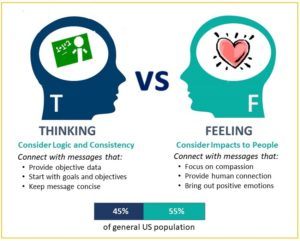You may have heard of the Myers-Briggs Type Indicator (MBTI), a personality profiler that has been around for decades but still widely used in business settings. Recent statistics show that eighty-nine of Fortune 100 companies use the MBTI either in the hiring process or in the workplace for team-building exercises, leadership coaching, and executive talent management.
Based on the degree to which a person agrees or disagrees with statements in the MBTI inventory, one can be categorized according to 4 personality dichotomies (and in combination, 16 personality types) that are indicative of how individuals derive mental energy, process information, make decisions, and deal with the outside world. These dichotomies are not absolute – people can fall along a continuum for each dichotomy – and there can be fluidity over time as people develop and change through life experiences.
The widespread popularity of the MBTI, with its promise of offering greater understanding of what “makes people tick” naturally leads marketers to wonder how it might be leveraged to develop more effective promotional communications. In mass communications specifically, it is critical to ensure that messages appeal to the many different types of buyers/decision makers in the broader audience. Understanding how various types of consumers take in information and make decisions can help guide the development of an array of tactics that, in combination, may better ensure more potential buyers will be reached.
In this context, we offer several insights around two of the most relevant MBTI dichotomies for strategic communications: Sensing vs. Intuition, which reflects how people gather information, and Thinking vs. Feeling, which reflects how people organize information and make decisions.
Sensing vs. Intuitive

Definition: In processing information, Sensors focus on concrete, real-world data and application. They want to use their own five senses to evaluate input. Intuitives have a preference for interpreting and adding meaning to information they encounter, and rely more on their “sixth sense” gut reactions and hunches.
Marketing Insight:
Given their preference for concrete data, Sensors respond to communications that highlight facts and measurable experience in a straightforward way. To overcome sensors’ natural skepticism about broad and general claims, it’s usually necessary to provide details, ensure key questions are answered, and make the case for why they would need or want a product based on common-sense arguments.
In contrast, for Intuitives the “big picture” approach resonates more, as do analogies and symbols. As a result, they are drawn to messages that focus on possibilities and innovation. It’s best to start with headlines and/or conclusions, with emphasis on possibilities, so they can add their own internal sub-text and meaning.
Car ads are an example of how promotions can be designed to simultaneously appeal to both Sensors and Intuitives. Aspirational, high-level messages of luxury, enhanced lifestyle, and enjoyment are more likely to resonate with Intuitives, but also may effectively connect with Sensors when accompanied by facts and a list of practical features.
In print ads, if your campaign takes a minimalist approach with a high-level message of “Product X is Best for Your Lifestyle,” you might at least want to cite a website for more information to draw in the Sensors. Note that Sensors comprise 70% of the US population.
Thinking vs. Feeling

Definition: Thinkers look first for logic and consistency, making decisions by stepping back from the situation and taking an objective view, usually based on specific decision rules or criteria. Feelers prioritize consideration of the people involved and how they are impacted, stepping into the situation by taking an empathetic view and deciding on the basis of values.
Marketing Insight:
With Thinkers, the more objective data you can offer, the more likely you’ll capture interest and engagement. Present goals and objectives first and keep the message concise. Thinkers are less likely to respond to sweeping claims or declarations if they can’t be backed by data. They also are less susceptible to promotional tactics aimed at inciting emotions, instead focusing on the facts on which to base their judgments.
Alternatively, Feelers assess decisions based on values such as compassion and connection. If a promotion resonates emotionally, Feelers are apt to consider the product even if it is not something they thought they wanted or needed. However, hit a chord that touches a negative hot button for them, and Feelers may not even consider the product—even if it’s one they might otherwise like or need (think of the recent Gillette ad controversy).
Communicators often are trained to appeal to Feelers with an emotional hook or testimonials from a few people. But singular data is viewed as anecdotal by Thinkers, and it is important to include elements in promotions that will resonate with both Feelers and Thinkers (e.g., “75% of patients have been prescribed Product X for its improved efficacy; as we heard in these testimonials, patients do feel better on Product X”). There is a slight skew toward Feelers (55%) vs. Thinkers (45%) in the US population.
In promotional development, The MBTI offers a layer of insight to help create successful marketing campaigns that appeal to a widespread audience base. While there are 16 distinct MBTI personality types, if you can attune mass communications to the core dichotomies comprising these types, particularly those reflecting the cognitive functions of information gathering and organization, you can raise the odds that you successfully are addressing the varied intake preferences reflected in the entire market.
